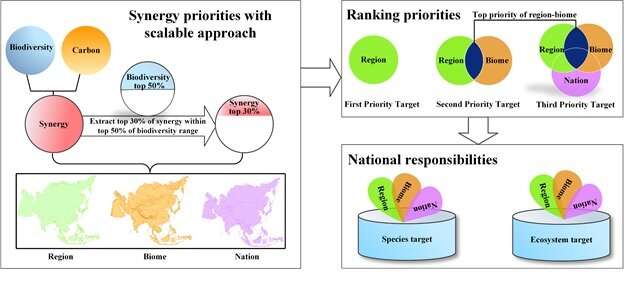Setting biodiversity and climate targets for national conservation action by 2030 in Asia

A research team led by Prof. Ma Keping from the Institute of Botany of the Chinese Academy of Sciences (IBCAS), in collaboration with scientists from multiple universities and research institutions, developed a scalable framework to identify complementary biodiversity and climate targets that are implementable at the national level whilst being reflective of broader biodiversity patterns.
In the last decade, the climate change movement has gained momentum and led to global action. Yet biodiversity failed to fulfill the original remit of any of the Aichi targets. The 15th Conference of the parties to the Convention on Biological Diversity (CBD-COP15) will be held in China this year to finalize and adopt the post-2020 global biodiversity framework (GBF) and determine the new global biodiversity target of 2030.
The preliminary draft of GBF puts forward the global goal of protecting 30% of the land and ocean area by 2030, highlighting the need for better targets and determining where should be prioritized for protection. By developing mutually beneficial targets which fulfill the remit of biodiversity and climate targets we have the opportunity to achieve far more than when looked at in isolation.
With the "30 by 30" target receiving increased support, the study explored how it could be most effectively implemented. It shows that 30% of Asian land could effectively protect over 70% of all assessed species relative to only 11% now, and allow storage of 2.3–3.6 hundred billion tons of carbon.
Although the analysis included 8,932 terrestrial vertebrates, improvements in effective protection were greatest in the taxa which currently have the lowest degree of effective protection, for example increasing the percentage of amphibians with effective protection from under 10% to over 80%, bringing their effective coverage in line with other vertebrate groups.
The study suggests that when countries select 30% of their land-area for protection target, priorities should be identified by first prioritizing global priorities, followed by continental (regional), then biome priorities. Such a ranking approach can maximize the diversity obtained effective protection per unit area.
Furthermore, due to the uneven distribution of biodiversity, 30% of land is not enough for some countries to conserve the majority of their species. For countries such as Indonesia, a far higher proportion is needed, as the majority of regional priorities fall in equatorial regions.
Additional mechanisms to enable financially viable approaches to maintain these regions are urgently needed if we are to bend the curve of biodiversity loss under equitable and viable targets which contribute towards global goals, whilst being implementable at the national level.
The research, titled "Regional scalable priorities for national biodiversity and carbon conservation planning in Asia," was published in Science Advances.
More information: Li Zhu et al, Regional scalable priorities for national biodiversity and carbon conservation planning in Asia, Science Advances (2021).
Journal information: Science Advances
Provided by Chinese Academy of Sciences



















